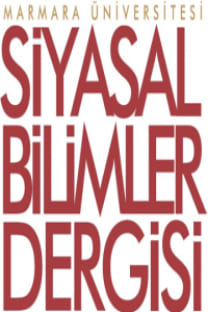Bosna Hersek'te Kadınların Siyasal Hayata Katılımı ve Temsil Edilmesi: 2014 ve 2018 Genel Seçimleri
Siyasal Katılma, Siyasi Temsil, seçim yasası, genel seçimler
Women’s Political Participation and Representation in Bosnia and Herzegovina: General Elections 2014 and 2018
___
- Action Plan for the Implementation of UNSCR 1325 in Bosnia and Herzegovina 2010-2013. Available at https://www.peacewomen.org/sites/default/files/bosniaherzegovina_nationalactionplan_2010.pdf
- Action Plan for the Implementation of UNSCR 1325 in Bosnia and Herzegovina 2014-2017. Available at https://arsbih.gov.ba/wp-content/uploads/2014/12/AP_1325_za_web.pdf
- Action Plan for the Implementation of UNSCR 1325 in Bosnia and Herzegovina 2018-2022. Available at https://arsbih.gov.ba/wp-content/uploads/2018/11/GAP-BiH-2018-2022_B.pdf
- Aganović, A., Miftari, E., and Veličković, M. (2015). 1995 – 2015 Women and Political Life in Post-Dayton Bosnia and Herzegovina. Sarajevo: Sarajevo Open Centre.
- Alađuz, Dž. (2015). Analiza programskih dokumenata parlamentarnih stranaka u BiH iz rodne perspective. Sarajevo: Infohouse.
- Beijing Declaration and Platform for Action, 27 October 1995. Available at https://www.refworld.org/ docid/3dde04324.html
- Bečić, E., & Alađuz, Dz. (2015). Žene u politici – Da li je veličina važna? (Analiza načina izvještavanja štampanih medija o kandidatkinjama na Općim izborima 2014. godine u Bosni i Hercegovini tokom predizborne kampanje). Sarajevo: Udruženje Infohouse. Available at http://ba.boell.org/sites/default/ files/zene_u_politici_-_da_il_je_velicina_vazna_-_mail-web.pdf
- Berry, E. M. (2018). War, Women and Power: From Violence to Mobilization in Rwanda and Bosnia – Herzegovina. Cambridge: University Press.
- Borić, B. (2005). “Application of Quotas: Legal Reforms and Implementation in Bosnia & Herzegovina” in Ballington J. and Francensca B. (eds.,) The Implementation of Quotas: European Experiences. Stockholm: International Institute for Democracy and Electoral Assistance, pp.38-43.
- Burnet, J. (2012). “Women’s Empowerment and Cultural Change in Rwanda.” In Susan Franceschet, Mona Lena Krook, Jennifer M. Piscopo (Eds.). The Impact of Gender Quotas. Oxford University Press. Central Election Commission of Bosnia and Herzegovina (CIK). Available at www.izbori.ba
- Dayton Peace Agreement, General Framework Agreement for Peace in Bosnia and Herzegovina, 21 November 1995. Available at https://www.refworld.org/docid/3de495c34.html
- Election Law of Bosnia and Herzegovina, “Official Gazette of Bosnia and Herzegovina,” No. 23/1, Article 9.8 (2) and No. 31/16, Article 29.
- Gender Action Plan for BiH (2006-2011). Available at https://arsbih.gov.ba/wp-content/uploads/2014/02/006-
- Gender-Action-Plan-of-Bosnia-and-Herzegovina.pdfGender Action Plan (2013-2017). Available at https://arsbih.gov.ba/wp-content/uploads/2014/02/GAP_BIH_ENGLISH.pdf
- Irvine, J. A. (2013). “Leveraging change: Women’s organizations and the implementation of UNSCR 1325 in the Balkans,” International Feminist Journal of Politics, 15(1): 20-38. Law on Gender Equality in Bosnia and Herzegovina (Official Gazette of Bosnia and Herzegovina, No. 16/03,102/09 and 32/10). Available at https://arsbih.gov.ba/wpcontent/uploads/2014/02/GEL_32_10_E.pdf
- Manjima Bhattacharjya, et al. (2013). “Why Gender Matters in Activism: Feminism and Social JusticeMovements.” Gender & Development. 21(2), pp. 277–293.
- Miftari, E. (2015). Politička participacija žena u Bosni i Hercegovini: Analiza učešća žena na stranačkim listama i konačnih rezultata općih izbora 2014. Sarajevo: Fondacija CURE, Sarajevski otvoreni centar.
- Mirović, D., Hadžić, I., and Miftari, E. (2015). Godišnji izvještaj o stanju ljudskih prava žena u Bosni i Hercegovini u 2014.godini. Sarajevo: Sarajevski otvoreni centar.
- Mulalic, M. (2011). “Women’s NGOs and Civil Society Building in Bosnia-Herzegovina,” Epiphany: Journal of Transdisciplinary Studies, 4(1), pp. 40-55.
- Osmanović, A. (2015). Zastupljenost žena u politici – Istraživanje – Hrvatska, Srbija, Crna Gora, Makedonijai BiH. Sarajevo: Infohouse. Simić, O. (2015). “Gender (in)equality in Bosnia and Herzegovina: One step forwards, two steps back,” in S.
- P. Ramet and C. Hassenstab (eds). Gender (In)equality and Gender Politics in Southeastern Europe: A Question of Justice (Gender and Politics). London: Palgrave Macmillan, pp. 87-107.
- Veličković, M. (2014). Stranke, izbori, parlamenti: Žene u politici u Bosni i Hercegovini. Priča u brojkama. Sarajevo: Sarajevski otvoreni centar.
- Yayın Aralığı: Yılda 2 Sayı
- Başlangıç: 2013
- Yayıncı: Marmara Üniversitesi
Kamu Bilgisine Erişim Düzenlemeleri ve Açık Devlete Etkileri: Türkiye Örneği
Yerel Yönetimlerde Çocuk Katılımı: Kâğıthane Çocuk Meclisi Örneği
Mustafa Kemal ÖKTEM, İrem Ece AKPINAR, Hülya KÜÇÜK
Bosna Hersek'te Kadınların Siyasal Hayata Katılımı ve Temsil Edilmesi: 2014 ve 2018 Genel Seçimleri
“Realist” İdealizm? 1977-1978 Senelerinde ABD-Suudi Arabistan İlişkileri Üzerine Bir Değerlendirme
Fransa’da Yerel Yönetimlerce Kullanılan Anayasal Bir Araç: Deney
Fransa’da Değişen Siyasal Paradigma Çerçevesinde Radikal Solun Yükselişi
Şenol ARSLANTAŞ, Düzgün ARSLANTAŞ
Mohammad Reza DEHSHIRI, Hossein SHAHMORADI
Türk Dış Politikasında Parti Rekabeti: Rakip Partilerin Politika Revizyonlarını Anlamak
Avrupa Birliği Doğu Ortaklığı Projesinin Gürcistan’a Etkisi
